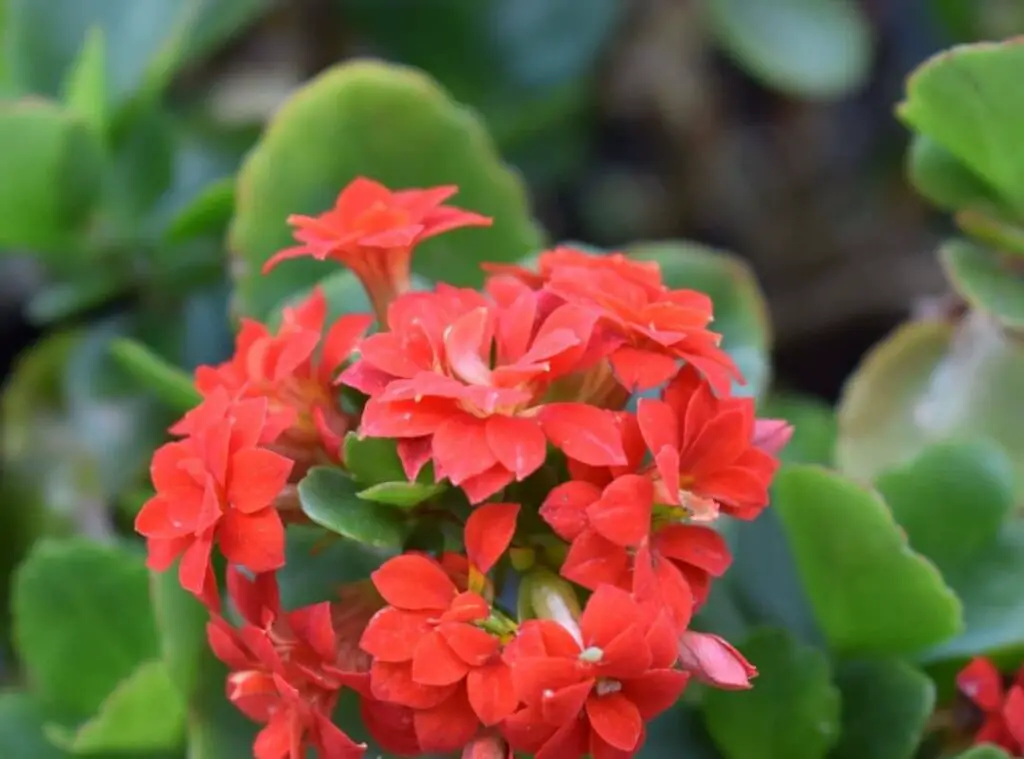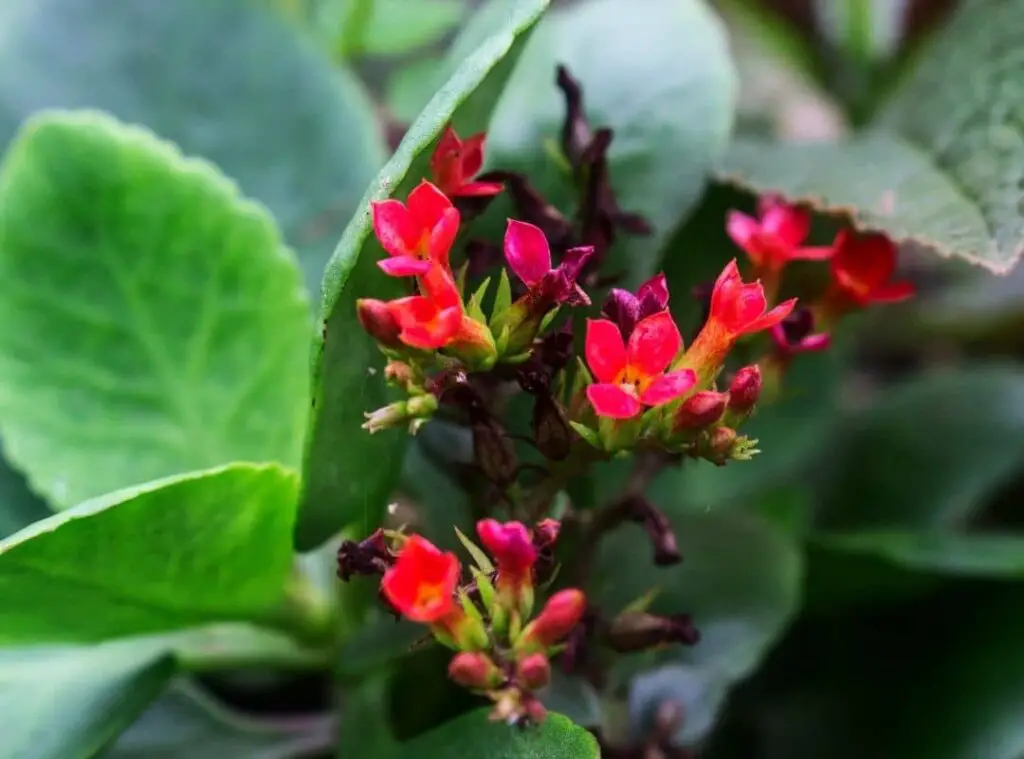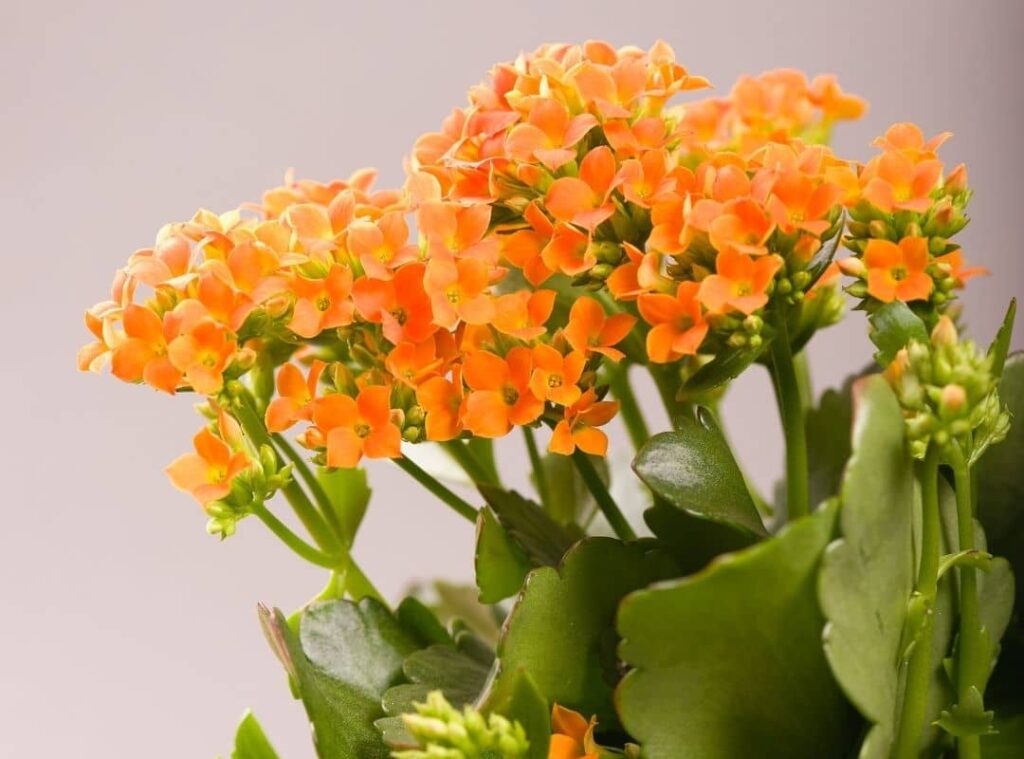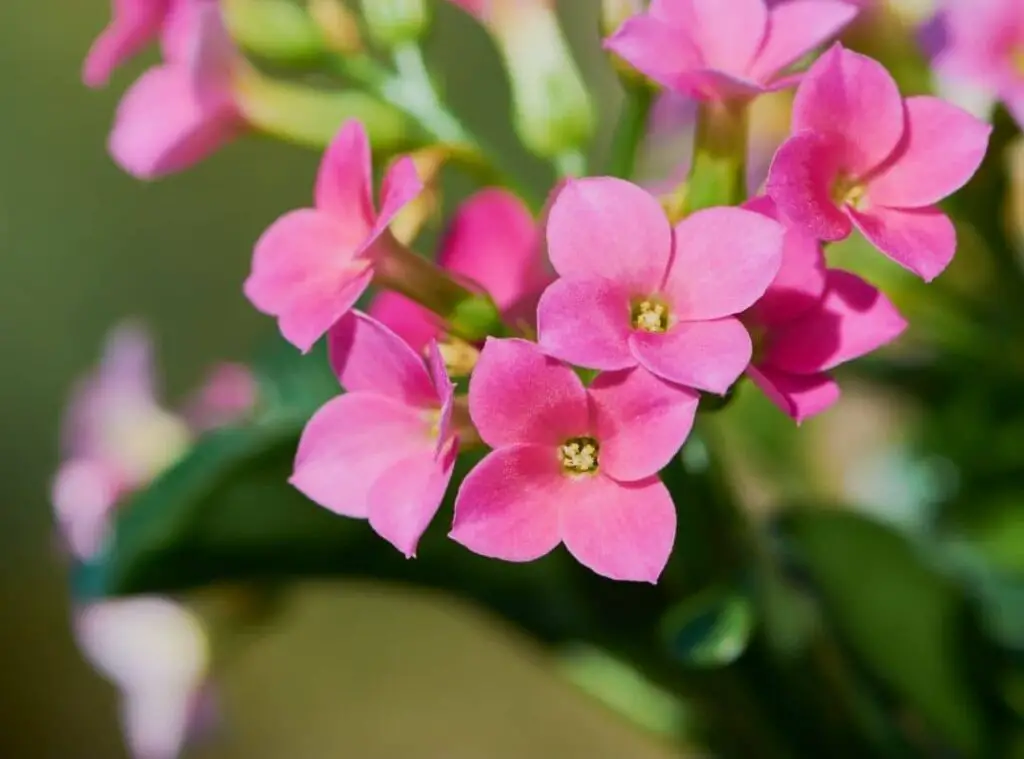Flaming Katy plants are undoubtedly one of the best flowering plants which you could display at your home. In this article we are going to discuss about flaming katy care and much more

One look Care guide
| Botanical Name | Kalanchoe blossfeldiana |
| Common Name | Flaming Katy Christmas kalanchoe Florist kalanchoe Madagascar widow’s-thrill |
| Plant Type | Succulent |
| Mature Size | 12 inches high and wide less than 12 inches |
| Sun Exposure | Full sunlight to partial sunlight |
| Soil Type | Well-draining |
| Soil pH | Acid, Alkaline, Neutral |
| Bloom Time | Spring |
| Flower Color | Red, orange, pink or yellow. |
| Hardiness Zones | USDA 10-12 |
| Native Area | Madagascar |
| Toxicity | Toxic for pets and for humans |
Water requirements and watering schedule
They are not fuzzy plants When it comes to watering. This would be a great choice for someone who occasionally forgets to water their plants.
In fact, you need to water the flaming Katy sparingly. That is because they have conserved water in their chubby and fleshy leaves. Their water conservation could last for several weeks.
However, when you water the flaming katy plants, you should water them thoroughly after ascertaining that the soil is in dry condition.
This is quite similar to the rest of other cactus and succulents water requirements. If I am to mention a watering schedule, once a week watering should be enough during summer .
On the other hand, if it is during the winter season, you could water these plants maximum once every couple of weeks.
How much sunlight do they need
These are an interesting set of plants since they could thrive in darker areas in your office and in your home for about a month’s period.
So, if you have selected a dark spot, you could possibly keep this plant there.
Having said that, if we consider providing a low level of sunlight for flaming Katy for a prolonged period, it will result in many repercussions.
Your plants would tend to take a leggy and spindly look. It would make the plant look ugly. It is important that they get bright sunlight for about one hour daily.
If you keep failing to fulfil their sunlight requirement, chances are that you would finally end up losing your beloved plant.
As such, make sure that you grow them in a location where they are exposed to proper sunlight.
In terms of temperature, the best recommended temperature to grow flaming katy would be 10 degrees Celsius to 22 degrees Celsius (50 degrees Fahrenheit – 72 degrees Fahrenheit).
They would tolerate temperature ranges slightly more than those as well. However, you need to make sure that you avoid exposing them for frost as they cannot withstand those conditions.

Soil condition and how to choose better soil
It is mandatory that you provide a well-draining soil medium for them to grow well. further it would prefer to grow in a sandy loose soil mix which is light in weight too.
They would thrive in salty soil and that is something interesting about this plant.
You could add some moisture retaining material in their pot. However, avoid putting too much of it though. Ideally, they should be light and fluffy.
Coconut coir would perfectly fit in the soil mix of these cactus. When you add those, it will make sure that the soil mix will stay light despite it being wet in condition.
Moreover, it would make sure that the abundant water drains away from the draining holes as well. You could consider adding perlite if you cannot find coarse sand for this purpose.
Humidity
Flaming katy are not fuzzy when it comes to humidity. However, if you expose them to low humidity levels, that will help them to protect them from fungal diseases.
Feeding flaming katy
If your flaming Katy is flowering, you could skip applying fertilizers. However, when the flowers have faded, you could consider adding a standard houseplant feed.
However, Instead of standard houseplant feed, you could use a fertilizer which is specifically designed for flowering plants.
Those fertilizers would be high in potassium levels and they would be beneficial to have more flowers when they rebloom.
When you feed them, you could feed them once every couple of months.
Pot type and pot size for flaming katy
I would suggest the terra cotta pots to grow flaming katy. They would perfectly suit the draining requirement of these cacti. Further it will fulfil the moisture needs of these cacti as well.
How much they grow
These cacti are known for a slow growth rate despite how good you care and treat them.
However, since they are compact in size, the little growth they show will make the plant look entirely different.
It will take about three to five years for them to gain their maximum height as well as their maximum width.
These plants tend to grow compact and that will make them look very pretty. Their leaves would be chubby and could be waxy.
They would further have sculpted edges as well. Their height would be about 12 inches and could be little, smaller in width.
Flowers
They would produce flowers in red, pink, orange, yellow, purple and even in white. They would form in a single manner or with four petals or even with eight petals.
They would usually bloom with about fifty flowers at one time.

Are flaming katy poisonous?
They are poisonous for both humans as well as for pets such as cats and dogs if you consume them in larger amounts.
In terms of symptoms, they could be either mild or severe depending on the quantity you consumed.
Symptoms such as vomiting, and diarrhea would be visible once you consume them in larger amounts.
Origins
Flaming katy are native plants in Africa and in Madagascar. They belong to the genus kalanchoe.
Uses of the plant
You could use the flaming cactus to get away from winter doldrums. In addition to that, this is used as an interior plant as well.
Flaming katy diseases
Flaming Katy plants are usually tolerant of pests’ attacks. Having said that you would still come across insects and pests attacks when growing them .
As such whenever you spot any pests attack, you need to attend to them then and there. Pests such as scales, mites’ weevils’ , mealybugs and aphids could be very annoying when growing them.
Aphids
When your flaming katy plant is under attack by aphids, you could spot them as individual crawling bugs. You could spot them at once to your naked eye.
Further you could see the white skin of the aphid on the plant surfaces. Aphids could be parasitic to the plant whilst making it weak. Further it could cause stunt growth and leaf drop in the plant.
To treat them, you could rub the plant parts with a soft brush whilst using isopropyl alcohol. Apart from that you may also use neem oil spray which would repel them.
Furthermore, you may also use a nontoxic insecticide to overcome them.
Mealy Bugs
Mealybugs could also attack these plants. They are little creatures which you could spot in white. They would cause stunt growth in the plant.
Moreover, they could cause yellowing of leaves and in leaf drop as well. Further mealybugs could absorb plant sap particularly in leaves.
They could be so annoying since they could reproduce faster and could cause greater damages to the plant.Ultimately you will lose the plant.
The earliest indication of the mealybug attack would be fluffy deposits at the stem bases. Further you could spot the eggs of the mealybugs underneath the leaves.
Moreover they could form some sticky fluid which could result in sooty mold on the leaves of the plant.
To overcome this, you may use an insecticidal spray . Alternatively you could choose a non-chemical way to get rid of them too. It is up to you to decide.
Powdery Mildew
Powdery mildew is yet another creature which could be annoying for these plants. They could be highly contaminating, and it could be even lethal for your plants if you do not treat them well in advance.
Initially you could spot a white coating on the leaves and on the stems as well. They would be fluffy when you look at them once they grow older.
You could spot them commonly when the plant is receiving low light levels along with poor aeration.
Therefore, whenever you spot any, it is important that you treat them whilst using a fungicide. When doing this, make sure that you take off the badly affected leaves as well as dead leaves.
Ultimately you could shift the plant to a place where it could get higher light and a better aeration as well.
Spider mites
Spider mites could also invade these plants and they would also absorb the moisture of the plant. Not only that but also, they would consume the tissues of the plant as well.
To treat them, you could use neem oil and this is the most common treatment that people use to do.

Flaming katy problems
Dead flowers
You will spot plenty of dead flowers particularly during their flowering season. However, you could trim the flower stems once the blooms fade away.
Consequently that would be helpful to produce more flowers. Ideally you could cut them at the plant base so that it would make sure that the plant will look good.
Further if you spot any random flower drop which happens suddenly, that could be mainly due to them being exposed to drought conditions for too long.
Those flowers would be having yellow stalks when this takes place.
On the other hand, if you think the plant is lacking enough flowers, that could be due to insufficient dormancy period where the temperature remains the same during the whole year.
As such, best is to reduce the temperature by two to three degrees during fall and in winter seasons.
Katy wilting
If you have under-watered your flaming Katy plant, key wilting is the most common issue which you will come across among these plants.
However, over watering could also affect them in wilting. Whenever you spot the wilting of the plant, you need to feel the soil and check whether it is too dry.
If it is so, you need to immediately commence watering them. On the other hand, if it is wet, over watering is the reason for the wilting of the plant.
If the plant is under water, you could remedy that by watering them adequately and that would help them to revive. However, if over watering has caused the plant wilting, only a mild wilting could heal.
Dropping leaves
Over watering is what causes the dropping leaves of the flaming katy plants. If you notice the yellowing of the plant first before they drop, it could possibly be due to root rot.
To treat them, you could repot them in a well-draining soil mix. Further if you consider repotting them, you need to cut off the damaged roots.
However, when you do that make sure that they have enough roots left also.
Growing tall
It is mandatory that you provide enough sunlight for these plants to thrive well. That will keep them healthy and vigorous as well.
Having said that, if your plant is running out of the right amount of sunlight, they would tend to grow taller. The scientific term you could call this condition is etiolation.
To remedy this, you could consider pruning. You could even prune them significantly as they could tolerate it once they complete flowering.
In case, if you have exposed your plant to a low light level, you need to immediately change its location where it could get sufficient sunlight.
Dying
Flaming katy plants are an easy to care set of plants which is quite similar to the rest of other plants in the kalanchoe.
However, you would still face some common issues which we are going to learn in detail.
Root rot
Root rot is one of the most alarming issues which you will encounter when growing these plants.
The exposure for too dark light conditions along with soggy soil conditions for prolonged periods could result in root rots in these plants.
There would be symptoms such as yellowing of the leaves, moldy soil, stunted growth, rotten brown base when your plant is suffering from root rots.
Here, I would recommend taking the plant out from the pot to observe the health of the plant. if you see the roots have a yellow tinge, you could try saving the plant.
However, if the roots are mushy and brown, you need to take necessary action as soon as possible and treat them.
Turn in to yellow
Over watering could cause the flaming Katy plants to turn yellow. To treat it, you need to cut down on watering and let them dry.

Related questions
Is Flaming Katy a succulent?
Flaming katy is a succulent and they produce flowers which are tubular in shape. These are mainly grown as gift plants.
They would produce flowers in different colors such as red, yellow, lilac and in orange. On the other hand, the leaves of the plant would be fleshy.
How often should you water Flaming Katy?
I would suggest you stick your finger in the pot and see whether it is damp or dry and only then water them. If it is damp, refrain in watering them.
However, if it is dry, you could continue watering them. When you think the soil top surface is dry, it has to be ideally the first two inches of the soil dry.
How big does a Flaming Katy grow?
If you consider the flaming Katy plants which grow in their natural habitat, they will rise to 20 inches in height.
On the other hand, most of the indoor grown flaming katy plants would be 8-12 inches in height. They would be either 8 inches or 12 inches in width as well.
This is what makes them perfect fits for windowsills. In addition to that you could use them as ornamental plants simply due to the size of these plants.
Can you eat Flaming Katy?
You should not eat flaming katy. In fact, some parts of the flaming Katy plants are toxic. Their flowers are the most toxic part of the plant.
In case if you consume the plant in larger quantities, you will end up vomiting and in having diarrhea.
Conclusion
Flaming katy only needs a minimum care and would thrive well If we sometimes ignore caring for them also.
If you fulfil its basic growing conditions, they will flourish and reward you with a phenomenal plant in return.
You could give one of these plants to a beginner in gardening as well. Good luck with gardening with this beautiful plant!
Read more Panda Plant Problems | 7 Critical Problems And Solutions |
